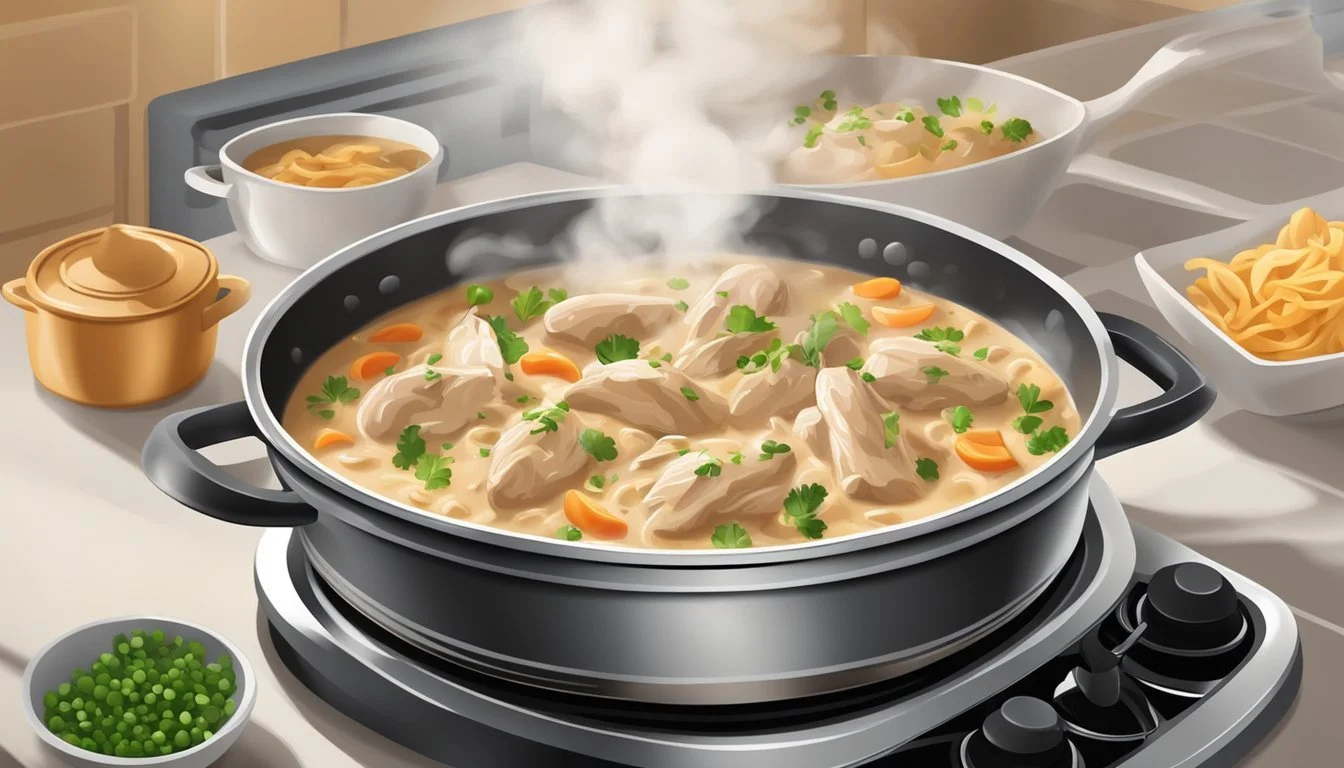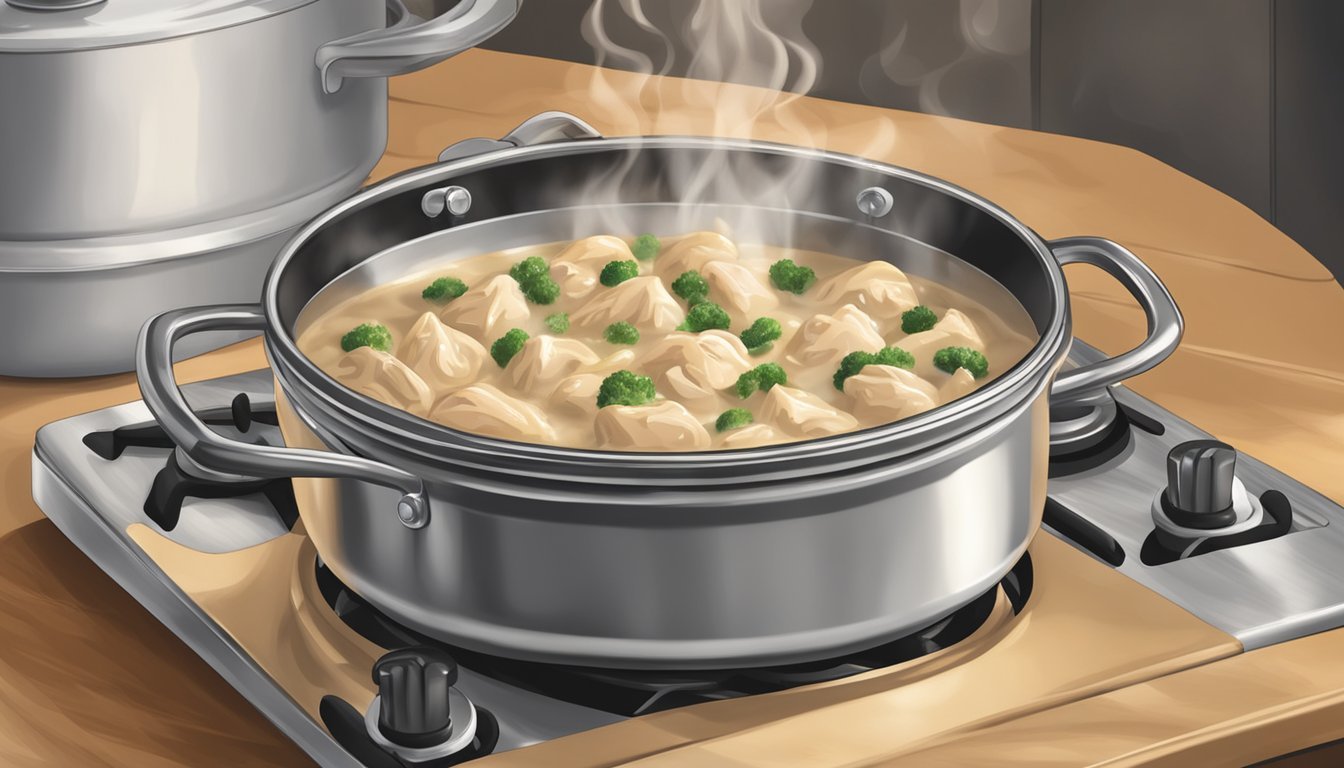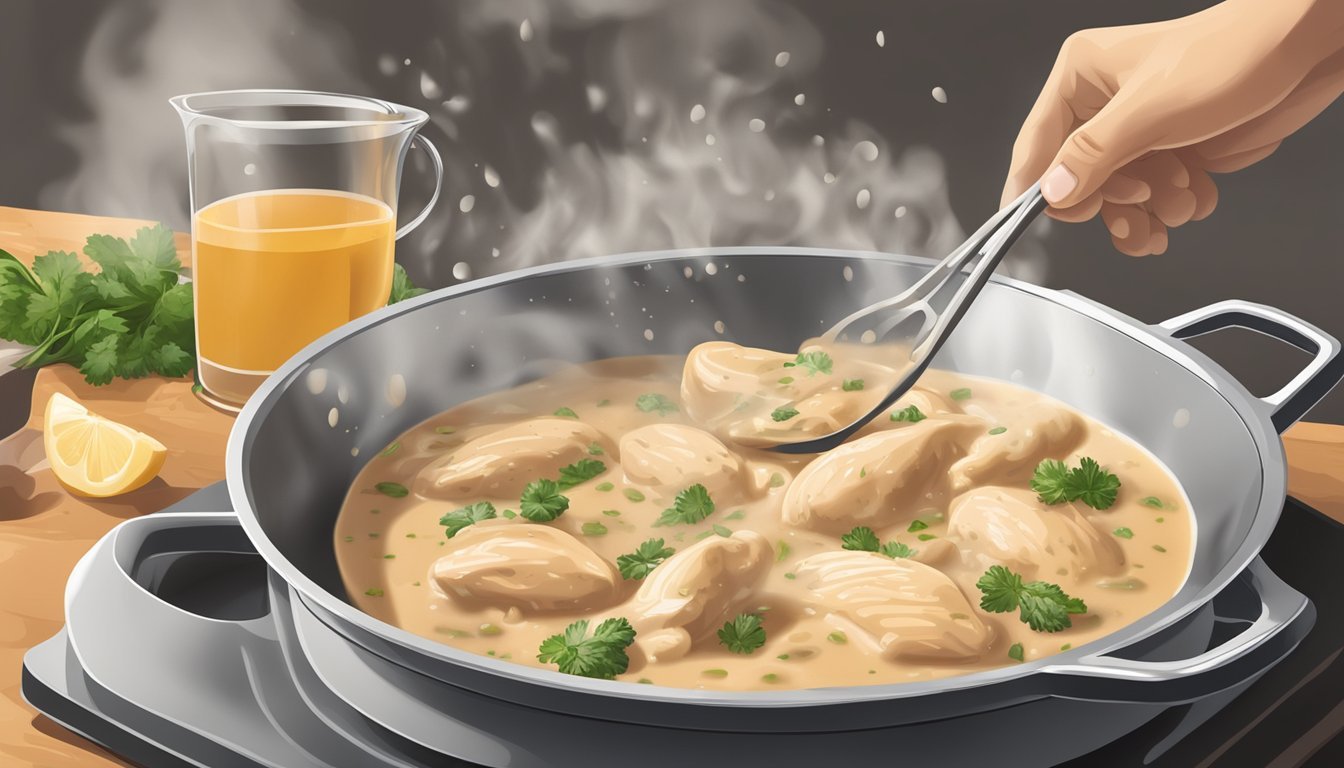Best Way to Reheat Chicken Stroganoff
Ensuring Creamy and Tender Results Every Time
Chicken stroganoff is a dish that charms the palate with its creamy sauce and tender chunks of chicken. Ensuring that the stroganoff retains its signature texture and flavor when reheated is essential. The key challenge lies in preventing the chicken from drying out and preserving the silkiness of the sauce, which can easily separate or become too thick upon reheating.
To maintain the delicate balance of flavors and textures in chicken stroganoff, specific reheating techniques are recommended. The process often involves adding moisture in the form of water, cream, milk, or stock, and using moderate heat to gently warm the dish without overcooking it. Covering the stroganoff during the heating process helps in retaining moisture and prevents the creamy sauce from reducing too much.
When it comes to reheating, one has to walk a fine line between thoroughly warming the stroganoff and keeping its components as close to their original state as possible. There are multiple methods to reheat this dish, each with its own set of nuanced steps tailored to protect the integrity of the chicken and ensure that every bite is as inviting as it was when first prepared.
Understanding Chicken Stroganoff
The dish Chicken Stroganoff is a sumptuous combination of tender chicken and a rich, creamy sauce, often served over pasta or rice. It's a variation of the classic beef stroganoff and has a distinct flavor profile that sets it apart. This section will break down the key aspects of Chicken Stroganoff, from its individual components and their textural contribution to its flavor complexities and nutritional content.
Components and Texture
Chicken Stroganoff comprises primarily of chicken, mushrooms, and onions sautéed in butter and then combined with a creamy mushroom sauce. The sauce typically contains sour cream, which brings a tangy richness, while added liquid such as stock or water helps to adjust consistency.
Chicken: Usually, the recipe calls for chicken thighs or breasts that are seared to preserve moisture.
Mushrooms: Provide an earthy flavor and a slight chewiness.
Onions & Garlic: These aromatic ingredients lend depth and sweetness upon gentle cooking.
Creamy Sauce: It is thickened with ingredients like flour and enriched with sour cream and mustard, which contribute to the creaminess.
The stroganoff's texture should be creamy but not overly thick, enveloping the chicken which should remain tender to the bite.
Flavor Profile
The dish is known for its rich, savory flavor with subtle hints of tanginess from the sour cream and a warming note from paprika. Here's how its primary flavors build:
Sour Cream: Adds a refreshing tang that balances the dish's richness.
Mustard: Introduces a mild heat and complexity.
Paprika: Offers a hint of smokiness and color.
The balance of these flavors ensures that each bite of Chicken Stroganoff is robust and satisfying.
Nutritional Value
Chicken Stroganoff is relatively high in protein due to the chicken content, while the sour cream and butter contribute to the fat, particularly saturated fat and cholesterol. The inclusion of mushrooms and onions provides dietary fiber and vitamins such as Vitamin A and Vitamin C. Here's a brief nutritional breakdown, assuming a standard serving size:
Nutrient Amount (approx.) Calories 350-450 kcal Protein 25-35g Fat 20-30g Saturated Fat 10-15g Carbohydrates 10-20g Fiber 1-3g Sugar 3-5g Sodium 500-700mg
The dish also includes minerals like potassium, calcium, and iron. However, it's worth noting that nutritional values can vary significantly based on the exact recipe and portion sizes.
Pre-Reheating Tips
When it comes to reheating chicken stroganoff, preserving its creaminess and tenderness is crucial. Achieving optimal results begins with proper storage and preparation methods before the reheating process even starts.
Storage Know-How
To ensure chicken stroganoff remains fresh and safe to consume, it should be stored in airtight containers to prevent contamination and moisture loss. The shelf life of chicken stroganoff in the refrigerator is typically 3 to 4 days. If one doesn't plan on consuming leftovers within this time frame, freezing is an option. When freezing, one should:
Seal the stroganoff in airtight containers or heavy-duty freezer bags.
Label with the current date to keep track of how long it's been stored.
Consider portioning it into single servings for easier thawing.
Freezing Tips:
Maximize freshness: Use within 2-3 months.
Avoid freezer burn: Wrap the container with a layer of aluminum foil or plastic wrap.
Preparation for Reheating
Before reheating, one should take some steps to ensure the stroganoff maintains its quality:
Thaw frozen stroganoff in the refrigerator if it was previously frozen.
Let it reach room temperature for 10-15 minutes before reheating to allow for more even heating.
Add liquid: A splash of broth or cream can help loosen up the sauce and prevent drying out.
Temperature and Safety:
Avoid using high temperatures which can cause the sauce to separate.
Aim for an internal temperature of 165°F (74°C) to meet food safety standards. Use a food thermometer to check.
By following these pre-reheating tips, one can help ensure that chicken stroganoff will return to its savory, creamy best upon reheating.
Reheating Techniques
Selecting the right reheating method ensures that the Chicken Stroganoff retains its creaminess and tenderness. Each technique provides different benefits to achieve even heating and maintain the quality of the dish.
Oven Reheating Method
The oven method involves evenly reheating the Chicken Stroganoff to prevent drying out. Preheat the oven to 350°F (175°C). Transfer the Stroganoff into an oven-safe dish, and add a small amount of water, stock, or cream to the dish for added moisture. Cover the dish with aluminum foil for moisture retention and place it on a baking sheet. Heat it for approximately 10-20 minutes, and stir halfway through to ensure even reheating.
Stovetop Reheating Method
Reheating on the stovetop allows for more control. Use a skillet, and add a little water, cream, or stock to the Stroganoff to keep it moist. Place the skillet over medium heat and stir frequently to avoid scorching. This method helps in evenly distributing heat and maintains the Stroganoff's creamy texture.
Microwave Reheating Method
For a quicker option, the microwave can be used, but careful attention is needed to avoid uneven heating. Place the Stroganoff on a microwave-safe plate or dish and cover it with microwave-safe plastic wrap or a damp paper towel. Use the medium power setting to avoid overheating, heating in intervals of one minute, stirring in between to distribute the heat.
Alternative Reheating Methods
Additional methods can include using a slow cooker on a low heat setting which gradually brings the Stroganoff to the desired temperature. An air fryer or broiler, although not common for this type of dish, can be used for components that might benefit from crisping up, but generally not recommended as they can quickly dry out creamy sauces.
Enhancing Creaminess and Flavor
When reheating chicken stroganoff, the key to maintaining its creaminess and flavor involves careful addition of dairy products, savory elements, and seasoning. Each component contributes uniquely to restoring the dish to its original lusciousness.
Adding Dairy and Fats
To reintroduce moisture and richness, one can add a small amount of dairy such as cream, milk, or even a dollop of Greek yogurt. This not only enhances the sauce's consistency but also ensures that the stroganoff remains creamy. It's essential to add these ingredients gradually and stir consistently to evenly distribute the creaminess. Butter can also be introduced for an added layer of flavor and to help the sauce achieve a velvety texture.
Recommended dairy additions:
Cream: 1-2 tablespoons
Milk: 1-2 tablespoons
Greek yogurt: 1 tablespoon
Utilizing Savory Add-Ons
Savory additions like chicken stock can effectively thin the sauce without diluting the flavor, providing the necessary liquid base for the dish when reheating. One might also consider a dash of Worcestershire sauce to deepen the savory qualities and introduce a subtle tanginess that complements the chicken and mushrooms.
Savory add-ons:
Chicken stock: as needed for desired consistency
Worcestershire sauce: ½ teaspoon
Herbs and Spices
Seasoning the stroganoff appropriately after reheating is crucial for reviving its flavors. Simple seasonings such as salt, pepper, and garlic powder are sufficient to accentuate the stroganoff’s natural taste. Fresh or dried herbs can also be sprinkled on top to add both aroma and a bright punch of flavor.
Seasoning to taste:
Salt: pinch, to taste
Pepper: freshly ground, to taste
Garlic powder: ¼ teaspoon
By balancing the addition of dairy, fats, savory components, and proper seasoning, one ensures that the reheated chicken stroganoff preserves the integrity and appeal of the dish.
Post-Reheating Tips
After successfully reheating chicken stroganoff, ensuring the dish maintains its creamy sauce and tenderness is paramount. Here are specific strategies to achieve the ideal texture and enhance the dining experience with appropriate serving suggestions.
Achieving Ideal Texture
Once the chicken stroganoff is reheated, one may find the sauce too thin. In such cases, they can thicken the sauce by incorporating a small amount of flour, whisked into a paste with cold water, before stirring it into the stroganoff. Doing so should be approached with care to avoid lumps. A creamy sauce is the hallmark of a good stroganoff, and one can restore it to its velvety consistency by adding a bit more cream, stirring gently under low heat.
Serving Suggestions
The best serving suggestions for chicken stroganoff feature neutral-tasting sides that complement the creamy texture and rich flavor of the dish. Egg noodles serve as a classic base, while a side of mashed potatoes provides a comforting alternative. For those who appreciate textural contrast, offering a slice of crusty bread can enhance the meal. This bread not only complements the sauce but also works excellently for sopping up any remaining creamy goodness from the plate.
Common Mistakes to Avoid
When reheating chicken stroganoff, several pitfalls can compromise its creaminess and tenderness. One needs to consider not just the preservation of heat but also the maintenance of texture and flavor.
Overheating: Reheating stroganoff until it boils can cause the sauce to separate and the chicken to become tough. It is crucial to gently warm the dish to just the right temperature.
Drying Out: Exposing stroganoff to high heat without proper moisture can dry out the sauce and meat. Adding a small amount of liquid (water, cream, or stock) is essential.
Separating Sauce: High heat can cause the dairy-based sauce to curdle or separate. To prevent this, one should opt for a low and slow heating method.
Here's a simple table to summarize:
Mistake Why Avoid How to Prevent Overheating Leads to tough chicken and separated sauce Gently reheat to just below a simmer Drying Out Results in a less creamy and unpalatable dish Add liquid and cover the dish while reheating Separating Sauce Causes curdling and breaks the creamy texture Use moderate heat and stir gently
When using a microwave, one should cover the stroganoff and heat in short intervals, stirring in between to prevent hotspots. In an oven, one covers the dish with foil and sets a moderate temperature, for example, 350°F (175°C). It's essential to stir the stroganoff at least once during the warming process. Whether using a stovetop, oven, or microwave, diligent attention to heat and moisture levels will yield the best results.
Frequently Asked Questions
Q: What is the best method to reheat leftover chicken stroganoff?
A: For optimal creaminess and tenderness, reheating in the oven is recommended. Preheat to 350°F (180°C), place chicken stroganoff in an oven-safe dish, and add a small amount of chicken broth to keep it moist. Cover with aluminum foil and warm for 10-20 minutes, stirring mid-way.
Q: Can I reheat leftover beef stroganoff in the microwave?
A: Yes, although it may not preserve the texture as well as other methods. Heat in a microwave-safe dish, covered, on medium power. Stir every couple of minutes and check the temperature with a food thermometer to ensure it reaches 165°F (74°C).
Q: How do I store leftover stroganoff to maintain its quality?
A: Store in an airtight container in the refrigerator within two hours of cooking. It should be consumed within 3-4 days for best quality.
Q: Is it safe to reheat chicken or beef stroganoff more than once?
A: It's best to only reheat the portion you plan to eat. Reheating multiple times can increase the risk of food-borne illness and compromise the dish's quality.
Q: Can I freeze leftover stroganoff?
A: Yes, stroganoff can be frozen. However, cream-based sauces may separate upon thawing. Freeze in airtight containers and consume within 2-3 months for best quality. Defrost in the refrigerator and reheat gently.
Don't's Do's Don't reheat on high power in the microwave Reheat gently to preserve texture Avoid reheating multiple times Use a food thermometer to check for safety






